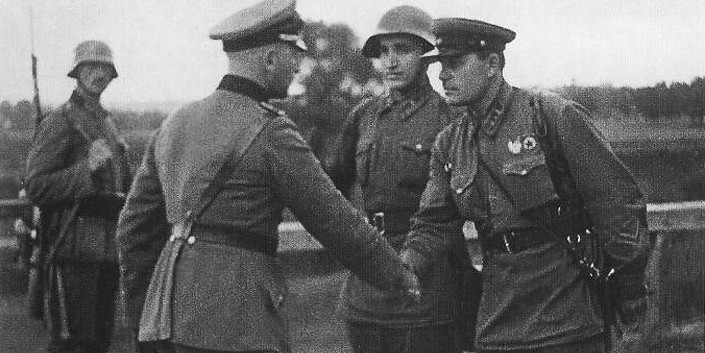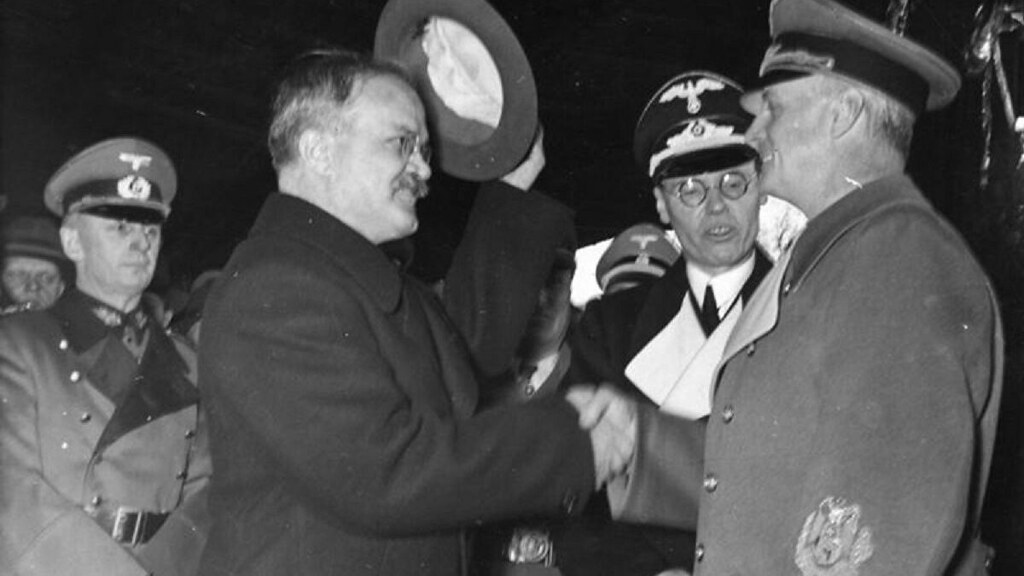United by hatred of democracy: a revealing telegram about the Nazi-Soviet pact of 1939
On September 1, 1939, World War II began, a conflict that broke out in 1939 with the invasion of Poland by Germany and the USSR.
A pact with which Hitler and Stalin shared five countries
That joint invasion of Poland was made possible by the signing of a pact between Germany and the USSR on August 23, 1939, which included a secret protocol by which Hitler and Stalin divided up Poland, Lithuania, Latvia, Estonia and Finland. One of the points that still puzzles many people today is how two antagonistic powers such as Nazi Germany and the Soviet Union were able to sign that pact. Let us remember that after coming to power, Hitler outlawed the Communist Party of Germany, while Stalin was dedicated to promoting anti-fascism in Europe. Likewise, Germany and Japan had signed the Anti-Comintern Pact in 1936, against the Communist International led from Moscow by Stalin.

A relationship that changed with the dismissal of a Soviet minister of Jewish origin
The rough edges between Germany and the USSR began to smooth over with the dismissal of Soviet Foreign Minister Maxim Litvinov, a Lithuanian of Jewish descent, on May 3, 1939, and his replacement by Viacheslav Molotov. The dismissal The minister's statement caused surprise throughout the diplomatic sphere, since Litvinov was in full negotiations with the British, with whom he had a good relationship. On May 4, the German Embassy in Moscow informed Berlin with a message stating: "The decision apparently is connected with the fact that differences of opinion arose in the Kremlin on Litvinov's negotiations. Reason for differences of opinion presumably lies in deep mistrust that Stalin harbors toward the entire surrounding capitalist world." The message from the German Embassy added a curious observation in line with the anti-Semitism of the Nazi Party: "At last Party Congress Stalin urged caution lest Soviet Union be drawn into conflicts. Molotov (no Jew) is held to be "most intimate friend and closest collaborator" of Stalin."
Telegram 175: a message that appealed to the common rejection of democracy
From there, the relationship between German and Soviet diplomacy became more fluid, as evidenced by the transcripts published by the Yale University Avalon Project, which include communications between German diplomacy and also between different states. One of those communications, without a doubt the one that marked a before and after in German-Soviet relations, was telegram 175 sent on August 14, 1939 by Joachim von Ribbentrop, German Foreign Minister, to the German ambassador in Moscow, Friedrich-Werner von der Schulenburg , a man who would end up being executed on November 10, 1944 for his involvement in the Kreisau Circle, a German anti-Nazi resistance group.

In that telegram, Ribbentrop asked the German ambassador to visit Molotov and communicate a message that began as follows: "The ideological contradictions between National Socialist Germany and the Soviet Union were in past years the sole reason why Germany and the U.S.S.R. stood opposed to each other in two separate and hostile camps. The developments of the recent period seem to show that differing world outlooks do not prohibit a reasonable relationship between the two states, and the restoration of cooperation of a new and friendly type. The period of opposition in foreign policy can be brought to an end once and for all and the way lies open for a new sort of future for both countries." After reviewing the foreign policy of both countries and their disagreements, in the 5th point of the message Ribbentrop presented Molotov with a common denominator between Nazis and Soviets:
"The Reich Government and the Soviet Government must, judging from all experience, count it as certain that the capitalistic Western democracies are the unforgiving enemies of both National Socialist Germany and of the U.S.S.R. They are today trying again, by the conclusion of a military alliance, to drive the U.S.S.R. into the war against Germany. In 1914 this policy had disastrous results for Russia. It is the compelling interest of both countries to avoid for all future time the destruction of Germany and of the U.S.S.R., which would profit only the Western democracies."
The German minister's message was not accidental: Ribbentrop knew that Nazis and communists had in common their rejection of liberalism and capitalism. In fact, much of the Nazi Party's anti-Semitic messages identified Jews as bankers and millionaires, as if they were the personification of a greedy upper class, a vision that coincided with the antisemitic pamphlet "On the Jewish question" written by Karl Marx.
The communist regime was delighted with the friendly German message
Someone who ignores the historical events that occurred shortly after will think, reading this, that Molotov and Stalin were not fooled by the blatant hook launched by the Nazis. It was not so. Rather, Schulenburg sent an urgent reply telegram to Ribbentrop on August 15, after meeting with the Soviet Foreign Minister: "Molotov received with greatest interest the information I had been authorized to convey, designated it as extremely important, and declared that he would report it to his Government at once and give me an answer shortly. He could already state that the Soviet Government warmly welcomed German intentions of improving relations with the Soviet Union and in view of my communication of today now believed in the sincerity of these intentions." What's more, Molotov immediately proposed "a non-aggression pact or something similar", according to the German ambassador. That is to say, that the Soviets were delighted with the message of friendship sent by the Third Reich.

Soviet diplomacy had already contacted fascist Italy
In a longer memorandum sent to Berlin on August 16, Schuleburg reported that in his meeting with the Soviet minister, Molotov confessed that at the end of June, the diplomatic delegation of the USSR in Rome had already held a meeting with the Italian Foreign Minister, Galeazzo Ciano, and that he had already told them that there was "a German plan under way which had as its goal a decisive improvement in German-Soviet relations", and that even then he had considered the possibility of signing "a non-aggression pact with the Soviet Union". That is to say, that the USSR was not only in talks with Nazi Germany, but also with fascist Italy. And that while numerous communists continued to regard Moscow as the staunchest bastion of anti-fascism...
After the signing of the pact between Germany and the USSR, on August 25, 1939 Hitler sent a letter to Mussolini explaining the reason for that agreement. The Italian dictator answered it that same day with another letter in the one that told him: "Concerning the agreement with Russia, I approve of that completely. His Excellency Marshal Goring will tell you that in the discussion which I had with him last April I stated that a rapprochement between Germany and Russia was necessary to prevent encirclement by the democracies." In other words, Mussolini was also in favor of that pact between the National Socialist dictatorship and the communist dictatorship to compared to democratic countries.

The effects of the Soviet German pact on the communist parties
What these documents show, after all, is that the alleged antagonism between Nazism and communism is not as deep as many imagine, to the point that their common hatred of democracy ended up outweighing their differences. Proof of this is that a few months later, in February 1940, Dolores Ibárruri, "La Pasionaria", defended the Nazi-Soviet invasion of Poland from a newspaper of the Communist Party of Spain, in an infamous article riddled with lies attacking "English and French imperialism" and calling "fascist" to Poland, a democracy recently invaded by two allied dictatorships.
A few months later, the Communist Party of France was launched to sabotage the French war effort against the German invasion of their country, to later try to reach secret agreements with the occupiers. An attitude that only changed when Germany invaded the USSR in June 1941, an invasion that surprised Stalin, confident as he was in his alliance with Hitler.
---
Feature photo: German and Soviet soldiers fraternizing in Brest, where their forces met during the joint invasion of Poland (colorized photo by Mirek Szponar).
|
Don't miss the news and content that interest you. Receive the free daily newsletter in your email: Click here to subscribe |
- Most read
- The Pegasus case and how it could end with Pedro Sánchez due to a decision by France
- The brutal 'touch and go' of a Lufthansa Boeing 747 at Los Angeles Airport
- The real reason for Sánchez's victimizing letter using his wife as an excuse
- The ruins of the old Yugoslav radar station at Gola Plješevica, Croatia
- The deployment of Spanish soldiers of the Regulars and BRILAT near Russian territory
- The ten oldest national flags in the world that are still in use today
- Portugal confirms that it has begun its transition to the F-35 and indicates bad news for Spain

 ES
ES





Opina sobre esta entrada: